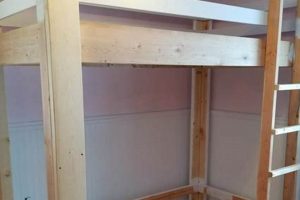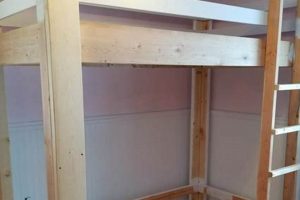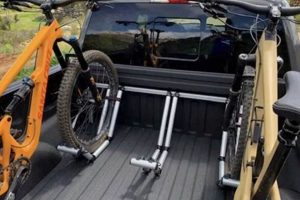A system created by an individual to arrange and compartmentalize items within the cargo area of a pickup truck is the focus. The undertaking involves constructing a storage solution, typically using readily available materials and tools, to efficiently manage equipment, tools, or other necessities. Examples encompass building custom drawers, dividers, or shelving units tailored to the specific dimensions and needs of the truck bed.
Efficient cargo management in a pickup truck offers enhanced safety, prevents damage to equipment during transit, and maximizes usable space. Historically, truck owners relied on rudimentary methods for securing items; however, the need for organized storage has grown with increased reliance on trucks for both work and recreational purposes. The implementation of purpose-built organization within the truck bed represents a significant advancement in functionality and usability.
Subsequent sections will delve into various construction techniques, material choices, design considerations, and adaptable strategies pertinent to building effective solutions for compartmentalizing cargo in a truck.
Essential Construction Guidance
The following insights offer critical considerations for the successful creation of a cargo management system for a pickup truck, ensuring durability, functionality, and safety.
Tip 1: Material Selection: Prioritize weather-resistant materials like pressure-treated lumber, marine-grade plywood, or durable composites to withstand exposure to the elements. These options minimize degradation and extend the life of the structure.
Tip 2: Precise Measurement: Accurate measurements of the truck bed’s interior dimensions are paramount. This ensures a snug fit, prevents shifting during transit, and maximizes available storage space. Consider wheel well protrusions and bed liner thickness.
Tip 3: Secure Fastening: Employ robust fasteners, such as lag bolts or carriage bolts, to securely attach the structure to the truck bed. This prevents movement and potential damage to both the organizer and the vehicle. Consider using existing tie-down points when possible.
Tip 4: Weight Distribution: Design the structure to evenly distribute weight across the truck bed. Uneven weight distribution can compromise vehicle handling and safety. Place heavier items lower and centrally within the organizer.
Tip 5: Accessibility: Plan for easy access to stored items. Drawers, sliding trays, and hinged lids provide convenient access while minimizing the need to unload the entire organizer. Ergonomic considerations are also relevant.
Tip 6: Safety Considerations: Incorporate safety features such as rounded edges and secure latches to prevent injuries and to keep cargo contained. Avoid sharp corners or protruding hardware that could pose a hazard.
Tip 7: Weatherproofing: Applying a sealant or protective coating to all exposed surfaces can dramatically improve weather resistance. This helps keep moisture out and prevent corrosion of metal components.
Adherence to these guidelines will result in a robust and functional storage solution, enhancing the utility and longevity of the truck.
The ensuing sections will discuss specific design examples and further considerations for customizing the storage system to individual requirements.
1. Material Durability
Material durability represents a critical determinant in the long-term effectiveness of any self-constructed cargo management system for pickup trucks. The selection of appropriate materials directly impacts the system’s ability to withstand environmental stressors and the rigors of daily use, thereby affecting its lifespan and overall value.
- Resistance to Environmental Exposure
Prolonged exposure to sunlight, moisture, and temperature fluctuations can degrade certain materials, leading to warping, cracking, or corrosion. For instance, untreated wood is susceptible to rot and insect infestation, while unprotected metals can rust. The use of weather-resistant materials, such as marine-grade plywood or powder-coated steel, mitigates these risks and preserves the structural integrity of the organizer.
- Load-Bearing Capacity
The selected materials must possess sufficient strength to support the anticipated weight of stored items. Insufficient load-bearing capacity can lead to structural failure, potentially damaging both the organizer and its contents. For example, using thin, low-grade plywood for shelves designed to hold heavy tools can result in collapse. Consideration of the material’s tensile strength and weight rating is therefore essential.
- Abrasion and Impact Resistance
The cargo bed of a truck is a dynamic environment, subject to abrasion from shifting loads and potential impacts from loading and unloading operations. Materials lacking adequate abrasion and impact resistance will exhibit wear and tear, compromising their appearance and potentially their structural integrity. High-density polyethylene (HDPE) or diamond plate aluminum are examples of materials chosen for their resistance to these types of damage.
- Chemical Resistance
Exposure to various chemicals, such as oil, gasoline, or cleaning agents, can degrade certain materials. Spillages within the truck bed are not uncommon, and the chosen materials must be able to withstand exposure to such substances without undergoing significant deterioration. For example, certain plastics may become brittle or discolored upon contact with specific chemicals. Consideration of chemical resistance is especially important if the organizer is intended for storing hazardous materials.
The facets outlined above highlight the crucial role of material selection in ensuring the durability and long-term functionality of a cargo management system. Choosing materials with appropriate resistance to environmental factors, load-bearing capacity, abrasion, impact, and chemical exposure directly translates to a more robust, reliable, and cost-effective solution for truck owners. Overlooking these considerations can result in premature failure of the system and potential damage to cargo.
2. Dimensional Accuracy
Dimensional accuracy constitutes a foundational prerequisite for the effective development of any cargo management system for pickup trucks. Precise measurements and adherence to specified dimensions are non-negotiable factors that directly influence the functionality, security, and overall utility of the constructed solution. Failure to prioritize dimensional accuracy invariably leads to compromised performance and potential complications.
- Optimal Space Utilization
Accurate dimensions ensure that the organizer maximizes the available space within the truck bed. Oversized components impede closure of the tailgate or encroach upon passenger space, while undersized components result in wasted volume. Precise measurements permit the creation of storage compartments perfectly tailored to the truck’s interior, eliminating wasted space and optimizing storage capacity. A practical illustration involves designing a drawer system: discrepancies in length or width can prevent smooth operation or render the drawer completely unusable.
- Secure Fit and Stability
Dimensional accuracy directly impacts the stability and security of the organizer within the truck bed. If the organizer does not fit snugly, it is susceptible to shifting during transit, potentially damaging both the organizer itself and the cargo it contains. Exact dimensions facilitate the creation of a secure fit, either through direct contact with the truck bed walls or through the incorporation of appropriately sized mounting brackets. Consider a shelving unit; if its height is miscalculated, it may not properly contact the truck bed’s roof or sides, resulting in instability and increased risk of collapse under load.
- Compatibility with Accessories
Many truck owners utilize bed liners, tonneau covers, or other accessories. Dimensional accuracy ensures that the organizer is compatible with these existing features. If the dimensions are not carefully considered, the organizer may interfere with the operation of a tonneau cover or prevent the proper installation of a bed liner. For example, building a tall storage box without accounting for the space required by a roll-up tonneau cover would render the cover unusable.
- Construction Precision and Efficiency
Dimensional accuracy streamlines the construction process, reducing the likelihood of errors and rework. Precise measurements allow for accurate cutting and assembly of components, minimizing material waste and labor time. Conversely, inaccurate measurements lead to misaligned joints, structural weaknesses, and increased material costs due to the need for corrections. Cutting lumber to incorrect lengths, for example, results in wasted material and the need for additional cuts, increasing the time and cost associated with the project.
In summation, dimensional accuracy is not merely a desirable attribute but a fundamental requirement for a successful outcome. Its influence extends from optimal space utilization and secure fit to compatibility with accessories and efficient construction. Ignoring this principle inevitably leads to a compromised outcome, diminishing the overall value and utility of the truck bed organizer.
3. Secure Mounting
Effective and secure integration of a cargo management system within a pickup truck bed hinges upon robust mounting methods. The implementation of appropriate attachment techniques ensures the system remains stable during vehicle operation, safeguarding both the organizer itself and its contents.
- Choice of Fasteners
The selection of fasteners dictates the strength and durability of the mounting points. Lag bolts, carriage bolts, and self-tapping screws represent viable options, each suited to specific materials and load requirements. For instance, lag bolts provide high holding power when securing wooden structures to the truck bed frame, while carriage bolts offer a flush, tamper-resistant connection. Inadequate fastener selection can lead to premature failure and separation of the organizer from the truck bed.
- Utilization of Existing Tie-Down Points
Many pickup trucks feature factory-installed tie-down points. Integrating these existing anchor locations into the mounting system offers a secure and convenient attachment method. By utilizing these pre-existing points, one avoids the need to drill new holes in the truck bed, preserving its structural integrity. However, it is critical to verify the load rating of the tie-down points and ensure compatibility with the chosen fasteners.
- Distribution of Mounting Points
The strategic placement of mounting points across the base of the organizer contributes to overall stability. Distributing the load across multiple attachment locations prevents stress concentration and minimizes the risk of failure at any single point. Concentrating all mounting points in one area can create a leverage effect, increasing the likelihood of detachment during sudden stops or sharp turns.
- Reinforcement of Attachment Areas
Reinforcing the areas where the organizer attaches to the truck bed enhances the strength and longevity of the mounting system. This can involve adding metal plates or brackets to distribute the load and prevent deformation of the truck bed or the organizer itself. Applying a backing plate to the underside of the truck bed, for example, can prevent the bolt from pulling through the sheet metal under heavy loads.
These considerations collectively highlight the importance of secure mounting for any truck bed cargo management system. Proper fastener selection, utilization of existing tie-down points, strategic distribution of mounting locations, and reinforcement of attachment areas ensure a robust and reliable installation. Neglecting these factors increases the risk of system failure, potentially resulting in damage to the organizer, its contents, and the vehicle itself.
4. Weight Management
The construction of a cargo management system necessitates careful consideration of weight management. An imbalance or excess of mass within the truck bed can compromise vehicle handling, fuel efficiency, and overall safety. Proper planning and execution of weight distribution are critical to mitigate these potential adverse effects.
- Material Selection Implications
The choice of materials directly influences the overall weight of the storage system. Dense materials like steel provide significant strength but can contribute substantially to the total load. Lighter alternatives, such as aluminum or high-density polyethylene, offer a favorable strength-to-weight ratio, minimizing the burden on the vehicle’s suspension. A steel drawer system, for example, will invariably weigh more than a comparable system constructed from aluminum or composite materials, impacting fuel economy and payload capacity.
- Distribution and Vehicle Dynamics
Evenly distributing the weight of stored items across the truck bed improves vehicle stability and handling. Concentrating weight towards the rear of the vehicle can reduce traction on the front wheels, affecting steering and braking performance. Likewise, an uneven distribution from side to side can induce body roll during cornering. Positioning heavier items near the truck’s cab and centering them between the wheel wells optimizes weight distribution and maintains balanced vehicle dynamics.
- Payload Capacity and Legal Compliance
Exceeding the vehicle’s specified payload capacity can damage the suspension, tires, and other critical components, as well as violate transportation regulations. Careful calculation of the organizer’s weight, in addition to the weight of the intended cargo, is essential to ensure compliance with these limits. The addition of a heavy storage system, combined with a full load of tools or equipment, can easily exceed the vehicle’s rated payload, leading to potential mechanical failures and legal ramifications.
- Accessibility and Ergonomics
Consideration of weight is also pertinent to the accessibility and ergonomic design of the cargo management system. Heavy drawers or sliding trays may require additional hardware, such as heavy-duty slides or gas struts, to ensure smooth and effortless operation. Failure to account for the weight of stored items can make accessing them difficult and potentially hazardous. A drawer loaded with heavy tools that is difficult to open or close poses a risk of injury and reduces the usability of the system.
In summary, weight management is not merely a secondary consideration but an integral element in the design and implementation of a truck bed cargo management system. Thoughtful selection of materials, strategic weight distribution, adherence to payload limits, and ergonomic design considerations collectively contribute to a safe, efficient, and functional solution.
5. Accessibility Design
Effective design of a cargo management system for pickup trucks mandates that access to stored items be prioritized. The ease with which tools, equipment, or other necessities can be retrieved directly impacts the system’s utility and the efficiency of tasks performed using those items. A poorly designed system, where items are difficult to reach or require extensive rearrangement to access, undermines the very purpose of organization. Consequently, accessibility design functions as a crucial component in achieving a truly functional truck bed configuration.
Accessibility encompasses several key considerations. These include the placement of frequently used items in easily reachable locations, the incorporation of drawers or sliding trays for deeper storage areas, and the use of clear labeling to identify the contents of various compartments. For example, a plumber who frequently needs access to pipe wrenches should store them in a readily accessible location, such as a top drawer or a side-mounted rack. Conversely, infrequently used items can be stored in less accessible areas. The implementation of pull-out shelves allows access to items stored at the back of the truck bed without requiring the user to climb into the bed or unload other cargo. Furthermore, the height and reach required to access items should be considered to accommodate users of varying physical abilities.
In conclusion, accessibility design is not a peripheral consideration but a fundamental aspect of an effective cargo management system. A system that fails to prioritize accessibility diminishes efficiency, increases physical strain, and ultimately reduces the overall value of the organization effort. Integrating thoughtful design principles that promote ease of access is paramount for maximizing the benefits of a truck bed storage solution.
Frequently Asked Questions
This section addresses common inquiries regarding the design, materials, and construction of truck bed cargo management systems. The provided information aims to clarify crucial aspects and ensure informed decision-making.
Question 1: Is professional installation recommended over a do-it-yourself approach?
The determination hinges on the individual’s skill level, available tools, and desired level of customization. Professional installation ensures proper fit and secure mounting, potentially mitigating risks associated with improper construction. However, a self-directed build permits greater control over design and material choices, provided the individual possesses the requisite expertise.
Question 2: What are the primary considerations when selecting materials for a truck bed organizer?
Material selection must account for weather resistance, load-bearing capacity, and overall durability. Pressure-treated lumber, marine-grade plywood, and durable composites represent viable options. Metal components, such as steel or aluminum, necessitate corrosion protection. The intended use and anticipated environmental conditions should dictate the final material choices.
Question 3: How can the risk of theft be minimized when using a truck bed organizer?
Implementing security measures, such as locking compartments and a tonneau cover, reduces the potential for theft. Securing the organizer itself to the truck bed with tamper-resistant fasteners further deters unauthorized removal. Parking in well-lit areas and avoiding the storage of high-value items in plain sight are additional preventative measures.
Question 4: What safety precautions should be observed during the construction process?
Adherence to standard safety practices is paramount. The use of appropriate personal protective equipment, including safety glasses and gloves, is essential. Operating power tools requires careful attention to manufacturer’s instructions and established safety protocols. Ensuring adequate ventilation when working with paints, adhesives, or sealants is also crucial.
Question 5: How can the weight of a truck bed organizer be minimized?
Employing lightweight materials, such as aluminum or high-density polyethylene, reduces the overall weight of the system. Optimizing the design to eliminate unnecessary material and minimizing the number of components can further contribute to weight reduction. Distributing the load evenly across the truck bed is also essential for maintaining vehicle stability.
Question 6: What are the legal implications of modifying a truck bed with a cargo management system?
Regulations concerning modifications to vehicle cargo beds vary by jurisdiction. It is incumbent upon the vehicle owner to ascertain and comply with all applicable laws and regulations. Considerations may include weight restrictions, securement requirements, and visibility standards.
These frequently asked questions provide a foundation for understanding the crucial considerations involved in creating cargo management systems. The judicious application of this knowledge will facilitate the construction of effective and safe storage solutions.
The subsequent section will provide information to various design approaches to cargo systems.
The Value of a Custom Truck Bed Configuration
The preceding exploration of the considerations vital to building a “truck bed organizer diy” solution demonstrates that its success hinges upon careful planning and execution. Proper material selection, accurate measurements, secure mounting, weight management, and accessibility design all contribute to a functional and durable system. Furthermore, adherence to safety protocols during construction is crucial for preventing injury.
Investment in a meticulously crafted system yields considerable benefits, enhancing the utility and extending the lifespan of the vehicle. Diligent execution of these principles will allow realization of the full potential offered by a tailored cargo organization solution. Prospective builders should approach this task with seriousness and an understanding of its complexities to achieve optimal results.







